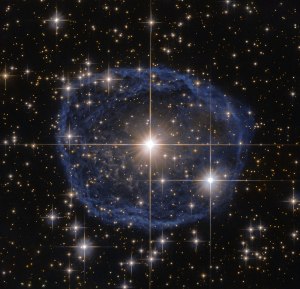A very rapidly evolving, supermassive star with a newly formed nebula only a few thousand years old
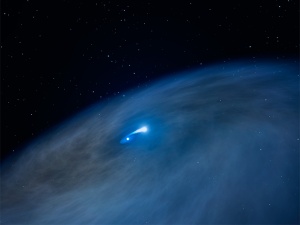
Space news (supermassive stars: Wolf-Rayet stars; star NaSt1) – 3,000 light-years away on the edge of a pancake-shaped disk of gas moving at 22,000 mph –
Astronomers using the Hubble Space Telescope have discovered new clues concerning a nearby supermassive, rapidly aging star they have nicknamed “Nasty 1”. Designated NaSt1 in astronomy catalogs, “Nasty 1” when first discovered decades ago was identified as a non-typical Wolf-Rayet star with an orbiting disk-like structure. A vast disk estimated to be almost 2 trillion miles wide astronomers now think formed due to a companion star snacking on its outer envelope. Putting NaSt1 in a class of Wolf-Rayet stars astronomers haven’t observed often during the human journey to the beginning of space and time. A star type possibly representing a transition stage in the evolution of supermassive stars.
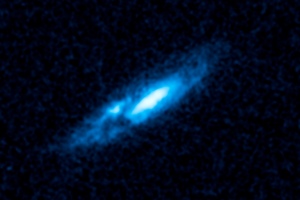
“We were excited to see this disk-like structure because it may be evidence for a Wolf-Rayet star-forming from a binary interaction,” said study leader Jon Mauerhan of the University of California, Berkeley. “There are very few examples in the galaxy of this process in action because this phase is short-lived, perhaps lasting only a hundred thousand years, while the timescale over which a resulting disk is visible could be only ten thousand years or less.”

In the case of NaSt1, computer simulations show a supermassive star evolving really fast and swelling as it begins to run out of hydrogen. Its outer hydrogen envelope is loosely bound and is gravitationally stripped from the star- astronomers call this process stellar cannibalism – by a more compact, nearby companion star. In the process the more compact star gains mass, while the more massive star loses its hydrogen envelope, exposing its helium core and eventually becoming a Wolf-Rayet star.
The mass-transfer model is the favored process for how Wolf-Rayet stars evolve at the moment and considering at least 70 percent of supermassive stars detected, so far, are members of binary star system, this seems logical. Astronomers used to think this type of star could also form when a massive sun ejects its hydrogen envelope. But the direct mass loss model by itself can’t account for the number of Wolf-Rayet stars observed relative to less-evolved supermassive suns in the Milky Way.
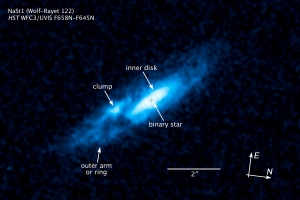
“We’re finding that it is hard to form all the Wolf-Rayet stars we observe by the traditional wind mechanism because the mass loss isn’t as strong as we used to think,” said Nathan Smith of the University of Arizona in Tucson, who is a co-author on the new NaSt1 paper. “Mass exchange in binary systems seems to be vital to account for Wolf-Rayet stars and the supernovae they make, and catching binary stars in this short-lived phase will help us understand this process.”

Astronomers computer models show that the mass-transfer process isn’t always perfectly efficient. Matter can only transfer from NaSt1 at a certain rate, left over material begins orbiting, creating a disk-like structure.
“That’s what we think is happening in Nasty 1,” Mauerhan said. “We think there is a Wolf-Rayet star buried inside the nebula, and we think the nebula is being created by this mass-transfer process. So this type of sloppy stellar cannibalism actually makes Nasty 1 a rather fitting nickname.”
Observing Nasty 1 (star NaSt1) through the clock of gas and dust surrounding this star system hasn’t been easy. The intervening disk-like structure even blocks the view of the Hubble Space Telescope. Scientists haven’t been able to measure the distance between the stars, their mass, or the volume of material transferring to the smaller companion star.
Astronomers have been able to discover a few items concerning the disk-like structure surrounding Nasty 1. Measurements indicate it’s traveling at around 22,000 mph in the outer nebula, a slower speed than recorded in other stars of this type. Scientists think this indicates a much less energetic supernova than was recorded for other events, like Era Carinae. In this case and other similar stars, the gas in the outer nebula has been recorded in the hundreds of thousands of miles per hour. Nasty 1 could be different supernova animal altogether.

Nasty 1 could also lose its outer envelope of hydrogen intermittently. Previous studies in the infrared light provided clues indicating the existence of a dense pocket of hot gas and dust close to the central stars in the region. More recent observations using the Magellan Telescope located at the Las Campanas Observatory in Chile has also detected a bigger pocket of cooler gas and dust possibly indirectly blocking light from these stars. Astronomers think the existence of warm dust in the region implies it formed just recently, perhaps intermittently, as elementally enriched matter from the stellar winds of massive stars collides, mixes, flows away, and cools. Irregular stellar wind strength, the rate at which star NaSt1 loses its outer envelope, could also help explain the observed clumpy structure and gaps noted in the outer regions of the disk.
Astrophysicists used NASA’s Chandra X-ray Observatory to measure the hypersonic winds screaming from each star. Readings showed a scorching hot plasma, indicating colliding stellar winds producing high-energy shockwaves that glow in X-rays. This is consistent with previous data collected on other evolving Wolf-Rayet star systems. We’ll get a better view once the outer hydrogen of Nasty 1’s (star NaSt1) depleted, and the mass-transfer process completes. Eventually, the gas and dust in the lumpy, disk-like structure will dissipate, giving us a clearer view of this mysterious binary star system.
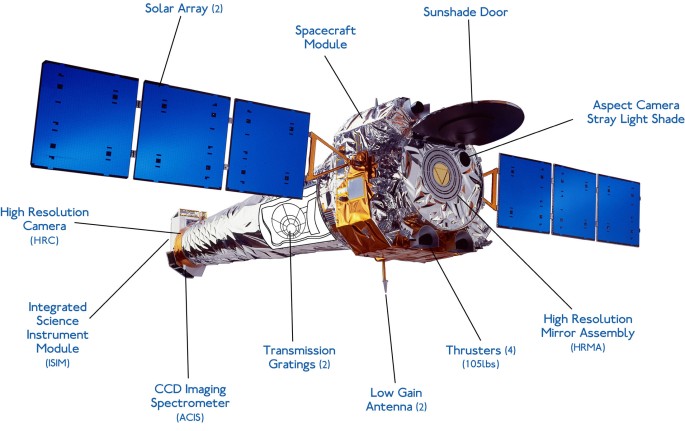
Nasty 1’s still evolving!
“What evolutionary path the star will take is uncertain, but it will definitely not be boring,” said Mauerhan. “Nasty 1 could evolve into another Eta Carinae-type system. To make that transformation, the mass-gaining companion star could experience a giant eruption because of some instability related to the acquiring of matter from the newly formed Wolf-Rayet. Or, the Wolf-Rayet could explode as a supernova. A stellar merger is another potential outcome, depending on the orbital evolution of the system. The future could be full of all kinds of exotic possibilities depending on whether it blows up or how long the mass transfer occurs, and how long it lives after the mass transfer ceases.”
Astronomers continue to study Nasty 1 and its peculiar, unusual disk-like structure looking for clues to explain the mysteries surrounding its origin.
Join the conversation and learn more about NASA here.
Take the space voyage of the ESA.
Learn more about the things the Chandra X-ray Observatory has taught us about the universe we live in here.
Learn more about Wolf-Rayet stars.
Discover the universe through the eyes of the Hubble Space Telescope.
Discover what the astronomy department at the University of California, Berkeley is up to here.
Learn more about supernovae.
Discover astronomy at the University of Arizona in Tucson.
Discover the Magellan Telescope.
Learn more about the Las Campanas Observatory in Chile.
Watch a Kepler animation of a supernova shockwave in visible light.
Read about the things astronomers are finding out about a type of galaxy called lenticular galaxies.
Read about the plans to construct the next-generation planet-hunter The Magellan Giant Telescope.



